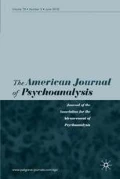Abstract
Empathic difficulty is a highly consequential characteristic of antisocial personality structure. The origin, maintenance, and possible resolution of this profound deficit are not very clear. While reconstructing empathic ability is of primary importance in the treatment of antisocial personality, not many proven procedures are in evidence. In this article, the author offers a psychodynamic formulation of the origin, character, and maintenance of the empathic deficiency in antisocial personality. The author discusses some of the treatment implications from this dynamic formulation.
Similar content being viewed by others
References
American Psychiatric Association (APA) (2000). Diagnostic and statistical manual of mental disorders. 4th Edition text revision (DSM-IV-TR). Washington DC: American Psychiatric Association.
Ansevics, N.L. (1983). A conceptual framework for intervention with the antisocial personality. Journal of Psychotherapy in Independent Practice, 1 (3), 43–52.
Baker, L.A., Jacobson, K., Raine, A., Lozano, D.I. & Bezdjian, S. (2007). Genetic and environmental bases of childhood antisocial behavior: A multi-informant twin study. Journal of Abnormal Psychology, 116 (2), 219–235.
Berman, S.M.W. & McCann, J.T. (1995). Defense mechanisms and personality disorders: An empirical test of Millon's Theory. Journal of Personality Assessment, 64 (1), 132–144.
Bion, W.R. (1955). Language and the schizophrenic. In M. Klein, P. Heimann & R.E. Money-Kyrle (Eds.), New directions in psycho-analysis (pp. 220–239 ). London: Tavistock.
Block, J. (1995). A contrarian view of the five-factor approach to personality description. Psychological Bulletin, 117 (2), 187–215.
Briggs, S.R. (1992). Assessing the five-factor model of personality description. Journal of Personality Assessment, 60 (2), 253–293.
Carlson, S.N. (2009). Whose hate is it? Psychoanalytic Review, 96 (6), 895–914.
Cima, M., Tonnaer, F. & Hauser, M.D. (2010). Psychopaths know right from wrong but don’t care. Oxford Journal of Social, Cognitive, & Affective Neuroscience, 5 (1), 59–67.
Dorr, D. (1999). Approaching psychotherapy of the personality disorders from the Millon perspective. Journal of Personality Assessment, 72 (3), 407–425.
Gacono, C.B., Meloy, J.R. & Berg, J.L. (1992). Object relations, defensive operations, and affective states in narcissistic, borderline, and antisocial personality disorder. Journal of Personality Assessment, 59 (1), 32–49.
Habel, U., Kuhn, E., Salloum, J.B., Devos, H. & Schneider, F. (2002). Emotional processing in psychopathic personality. Aggressive Behavior, 28 (5), 394–400.
Hare, R.D. (2008). Psychological instruments in the assessment of psychopathy. In A. Felthous & H. Sass (Eds.), The international handbook on psychopathic disorders and the law (pp. 41–67 ). Chichester, UK: John Wiley.
Jones, P.A., Happe, F.G.E., Gilbert, F., Burnett, S. & Viding, E. (2010). Feeling, caring, knowing: Different types of empathy deficit in boys with psychopathic tendencies and autism spectrum disorder. Journal of Child Psychology and Psychiatry, 51 (11), 1188–1197.
Klein, M. (1946). Notes on some schizoid mechanisms. International Journal of Psychoanalysis, 27, 99–110.
Klein, M. (1955). On identification. In M. Klein, P. Heimann & R.E. Money-Kyrle (Eds.), New directions in psycho-analysis (pp. 309–345 ). New York: Basic Books.
Klein, M. (1957). Envy and gratitude, a study of unconscious sources. New York: Basic Books.
Kohut, H. (1984). How does analysis cure? Chicago: The University of Chicago Press.
Lynam, D.R., Gaughan, E.T., Miller, D.J., Mullins-Sweatt, S. & Widiger, T.A. (2011). Assessing the basic traits associated with psychopathy: Development and validation of the elemental psychopathy assessment. Psychological Assessment, 23 (1), 108–124.
Malancharuvil, J. (2004). Projection, introjection, and projective identification: A reformulation. American Journal of Psychoanalysis, 64 (4), 375–382.
Martens, W. (2008). Introjective identification therapy for patients with antisocial personality disorders: A theoretical outline. Annals of the American Psychotherapy Association, 11 (4), 10–16.
Millon, T. (1996). Personality disorders: Conceptual distinctions and classification issues. In T. Millon (Ed.), Personality and psychopathology: Building a clinical science: Selected papers of Theodore Millon (pp. 11–38 ). New York: Wiley.
Ogden, T. (1991). Projective identification and psychotherapeutic technique. Washington DC: Jason Aronson.
Rodrigo, C., Rajapakse, S. & Jayananda, G. (2010). The “antisocial” person: An insight into biology, classification, and current evidence on treatment. Annals of General Psychiatry, 9 (31), 2–12.
Scharff, J.S. (1992). Projective and introjective identification and the use of therapist's self. New Jersey and London: Jason Aronson.
Schui, G. & Krampen, G. (2007). Historiography of research on aggression and emotion and its intersection in the last quarter of the 20th century. In G. Steffgen & M. Gollwitzer (Eds.), Emotions and aggressive behavior (pp. 3–16 ). Cambridge, MA: Hogrefe & Huber.
Shamasundar, C. (1999). Understanding empathy and related phenomena. American Journal of Psychotherapy, 53 (2), 232–245.
Waska, R. (2008). Why won’t the voices leave me alone? Patients who live in a world of persecutory anxiety. Psychodynamic Practice, 14 (2), 193–206.
Winnicott, D.W. (1967). Mirror-role of the mother and family in child development. In P. Lomas (Ed.), The predicament of the family: A psycho-analytical symposium (pp. 26–33 ). London: Hogarth.
Author information
Authors and Affiliations
Additional information
The views expressed in this article are those of the author and do not reflect the views of any institutions or agencies.
1Ph.D., A.B.P.P. is a Diplomat of the American Board of Professional Psychology (clinical) and has more than 30 years experience working with individuals with antisocial personality disorder. He was the Chief Psychologist and Clinical Administrator of one of the largest forensic psychiatric hospitals in the United States. He is a member of the American Board of Professional Psychology; the American Psychological Association, and the California Psychological Association. He is a fellow of the American College of Clinical Psychology.
Rights and permissions
About this article
Cite this article
Malancharuvil, J. Empathy Deficit in Antisocial Personality Disorder: A Psychodynamic Formulation. Am J Psychoanal 72, 242–250 (2012). https://doi.org/10.1057/ajp.2012.9
Published:
Issue Date:
DOI: https://doi.org/10.1057/ajp.2012.9




